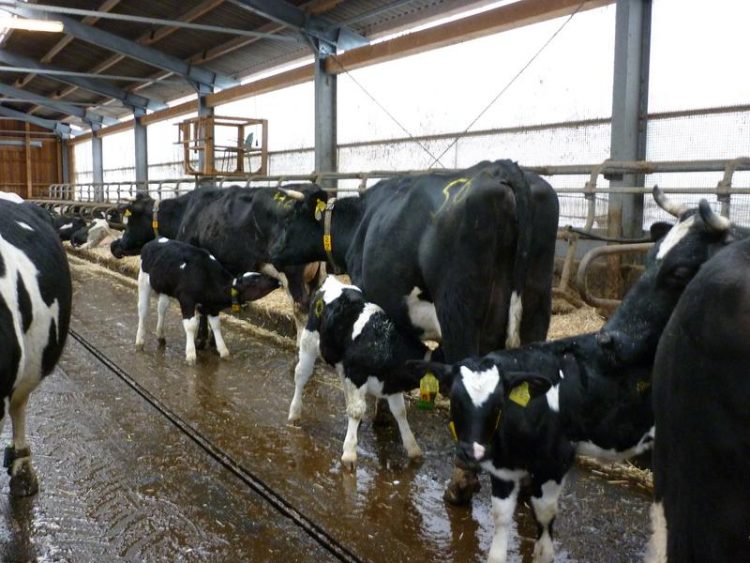Early separation of cow and calf has long-term effects on social behaviour

Contact to mothers and to other cows, makes calves more sociable and socially competent as adults. Photo: Kathrin Wagner/Vetmeduni Vienna
Drinking milk is a big tradition in Austria. The country produces 3.4 million tons of milk a year. To help achieve this volume, dairy cows are typically separated from their calves just a few hours after giving birth. The calves are then fed milk or milk substitute via bucket or from an automatic feeder.
The amount of milk the calves receive is usually much less than they would drink from their mothers. Calves and cows are therefore unable to form a relationship. After a few days or weeks in single housing, the young animals are usually transferred to a calf group.
Early separation has long-term effects
“Research has shown that the early social environment affects behaviour, stress reactivity and the ability to cope with different challenges in various animal species,” says project leader Susanne Waiblinger from the Institute of Animal Husbandry and Animal Welfare. Waiblinger and first author Kathrin Wagner studied these effects in dairy cows. A previously published substudy by the researchers already showed that rearing with maternal contact gives rise to adults with higher social competence.
Together with a group of colleagues from the Vetmeduni Vienna and the Thünen Institute of Organic Farming in Germany, Wagner and Waiblinger examined a total of 26 differently reared cows. Eleven animals were separated from their mothers immediately after birth before entering the calf group and being fed milk via automatic feeder.
The remaining 15 calves were kept with their mothers in the calving pen for the first five days and were able to establish a mother-calf bond during this time. These calves were then also moved to the calf area, but continued to have contact to their mothers. Nine of these calves were allowed access to their mothers twice a day, while the remaining six were able to move between the calf group and the cow herd at all times.
The scientists performed different tests with the grown-up animals to determine whether the different rearing strategies had a long-term effect on the behaviour of the animals in stress situations.
Animals reared with maternal contact are more active in stress situations
“Cattle are herd animals. As expected, all animals, whether they were reared with or without mothers, produced higher levels of the stress hormone cortisol when being isolated from the herd, ” Waiblinger explains. Cattle which grew up with their mothers expressed the highest levels of cortisol during isolation, but the heart rate measured in these animals was the lowest. Waiblinger explains: “There are fundamentally different reaction types. Some animals respond to stress situations with an increased heart rate, others produce cortisol. It is possible that the different rearing treatments result in different reaction types.”
Differences could also be seen in the animals’ behaviour. Calves reared with their mothers, especially those who had constant maternal contact as well as contact to the herd, were more active during isolation: they moved more in their calving boxes and explored their surroundings more actively than cattle reared without their mothers. This could indicate a higher level of motivation to rejoin the herd and a more active way to cope with the challenge of isolation.
The research shows that a richer social environment during rearing, i.e. with contact to mothers and to other cows, makes animals more sociable and socially competent as adults.
Mother-bonded rearing of dairy calves is already in use at a number of farms. “In the future, we must increasingly consider whether a socially restricted early environment represents the ideal form of animal husbandry,” Waiblinger argues.
The study formed part of Kathrin Wagner’s doctoral thesis in the BIOREC (Biological Responses to Environmental Challenges) Doctoral College. BIOREC is concerned with stress responses in different species of vertebrates. https://www.vetmeduni.ac.at/phd/biorec
Service:
The article “Effects of mother versus artificial rearing during the first 12 weeks of life on challenge responses of dairy cows”, by Kathrin Wagner, Daniel Seitner, Kerstin Barth, Rupert Palme, Andreas Futschik and Susanne Waiblinger was published in the journal Applied Animal Behaviour Science. doi:10.1016/j.applanim.2014.12.010 http://www.sciencedirect.com/science/article/pii/S0168159114003293
About the University of Veterinary Medicine, Vienna
The University of Veterinary Medicine, Vienna in Austria is one of the leading academic and research institutions in the field of Veterinary Sciences in Europe. About 1,300 employees and 2,300 students work on the campus in the north of Vienna which also houses five university clinics and various research sites. Outside of Vienna the university operates Teaching and Research Farms. http://www.vetmeduni.ac.at
Scientific Contact:
Prof. Susanne Waiblinger
Institute of Animal Husbandry and Animal Welfare
University of Veterinary Medicine, Vienna
T +43 1 25077-4905
M +43 664 60257-6966
susanne.waiblinger@vetmeduni.ac.at
Released by:
Susanna Kautschitsch
Science Communication / Public Relations
University of Veterinary Medicine Vienna (Vetmeduni Vienna)
T +43 1 25077-1153
susanna.kautschitsch@vetmeduni.ac.at
http://www.vetmeduni.ac.at/en/infoservice/presseinformation/press-releases-2015/…
Media Contact
All latest news from the category: Agricultural and Forestry Science
Newest articles

Bringing bio-inspired robots to life
Nebraska researcher Eric Markvicka gets NSF CAREER Award to pursue manufacture of novel materials for soft robotics and stretchable electronics. Engineers are increasingly eager to develop robots that mimic the…

Bella moths use poison to attract mates
Scientists are closer to finding out how. Pyrrolizidine alkaloids are as bitter and toxic as they are hard to pronounce. They’re produced by several different types of plants and are…

AI tool creates ‘synthetic’ images of cells
…for enhanced microscopy analysis. Observing individual cells through microscopes can reveal a range of important cell biological phenomena that frequently play a role in human diseases, but the process of…





















